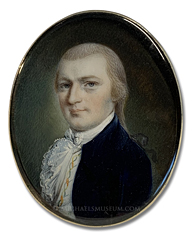| |
American Artist: John Ramage


Federalist Era Gentleman Wearing
a Russet Coat and Gold Vest with Stripes
American
circa 1790
by John Ramage (ca. 1748-1802)
1 1/4 x 1 5/8 inches (sight)
watercolor on ivory; housed in a later (not original to the portrait) gilt metal pendant frame
About the Artist: Though born in Dublin, Ireland in about the year 1748, John Ramage is considered one of the finest and most influential of early American miniaturists. So admired was his skill that, despite being a loyalist who fought against American independence, he was the first artist hired to paint a portrait of George Washington after his inauguration as the first President of the United States. (This iconic miniature portrait, painted in 1789, was sold at auction by Christie's in 2001 for $1.2 million -- the highest price ever paid for an American miniature.) Little is known of Ramage's early life, other than that he entered the Dublin Society Schools in 1763 and practiced briefly in London before relocating to Halifax, Nova Scotia in about 1771. In late 1774 or early 1775, he relocated to Boston, where he plied his trade as both a miniature painter and goldsmith (he made many of his own miniature portrait frames, fashioned out of gold). He was in Boston at the onset of the Revolutionary War, at which time he joined the The Loyal Irish Volunteers (a loyalist regiment), receiving a commission of lieutenant. At the conclusion of the Siege of Boston, he was amongst the large population of British subjects and loyalists who evacuated the city on March 17, 1776 with General William Howe's troops, en route to Halifax. He remained in Halifax a little more than a year, before then relocating by June, 1777 to New York City, which was then firmly controlled by the British and occupied by British troops. There, consistent with his loyalist leanings, he is recorded in 1780 as having served as a second lieutenant in a city militia loyal to the Royal Army. In New York, Ramage was met with great success, quickly becoming the leading miniature painter in that city. During the war, he painted numerous portraits of British military figures and prominent loyalists. Following the war, his his loyalist leanings seem not to have hurt his ability to earn commissions, as he continued to paint portraits of many early American sitters, including the likes of President George Washington (as noted previously), Gov. George Clinton (who later would serve as Thomas Jefferson's vice president) and William Few (a signer of the U.S. Constitution). In 1794, legal action was brought against Ramage due to his having guaranteed the debt of a friend who subsequently defaulted on that debt. As a result, a number of Ramage's household goods and furniture were seized and sold at auction on April 19, 1794, and Ramage himself fled to Montreal to avoid debtors prison. Letters written to his wife, who remained in New York, indicate that he was active as a miniaturist in Montreal and intended to save enough earnings as would allow him to return to New York. Declining physical and emotional health, however, prevented him from achieving this goal. He died in Montreal on October 24, 1802, having never been reunited with his wife. Listed by Barratt & Zabar (pages 38-42), Benezit, Blättel (pages 744, 745), Bolton (pages 131-133), Bolton & Wehle (pages 29, 30), Falk (page 2696), Fielding (page 764), Foskett (page 624), Johnson (pages 181-184), and Schidlof (pages 662, 663).
Other portraits in the Tormey-Holder Collection by John Ramage
(click photos for larger views and additional information):

Early American Lady

Killian K. Van Rensselaer (1763-1845;
Later a U. S. Representative, New York, 1801-1811),
Painted at the Age of 22
|
|